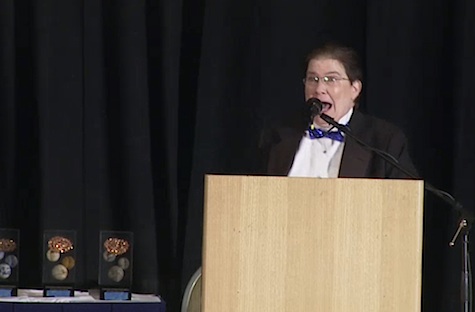Note: During the recent Nebula Awards streaming, Toastmaster Ellen Klages was called upon to entertain the audience while technical difficulties were resolved, a process that took much longer than anyone anticipated. This is, more or less, the story she told.
In the early ‘90s, my father’s brother gave him a Christmas present, a ham. Not the kind in a can, but a full-sized southern-style ham. A Smithfield ham. They are supposed to be aged a bit before serving, hanging for six months or a year in a dry Virginia smokehouse.
My father hung his in a damp Ohio basement.
For twenty years.
It hung in a corner of the room that held odds and ends, boxes and plastic bags of foam peanuts. When I was a kid, and we had a cat, it was the room that held the cat box and cat litter.
One day around 2005, I was helping my elderly father clean out a closet in the back hall. “Where do you want me to put these boxes? I asked.
“In the basement, in the room to the right of the stairs.”
“The scary ham and cat-shit room?” I asked.
He stared at me. “Why on earth would you call it that?”
I shrugged. “It’s where we used to keep the cat box, and it’s where the scary ham is.”
“It’s not a scary ham,” he harrumphed. “It’s a Smithfield ham. You’re supposed to hang it.”
Not for twenty years, I thought, but I did not say it out loud.
The ham was covered in some sort of netting, which was covered in many, many layers of mold and mildew. It loomed over the room. It made people gasp in horror.
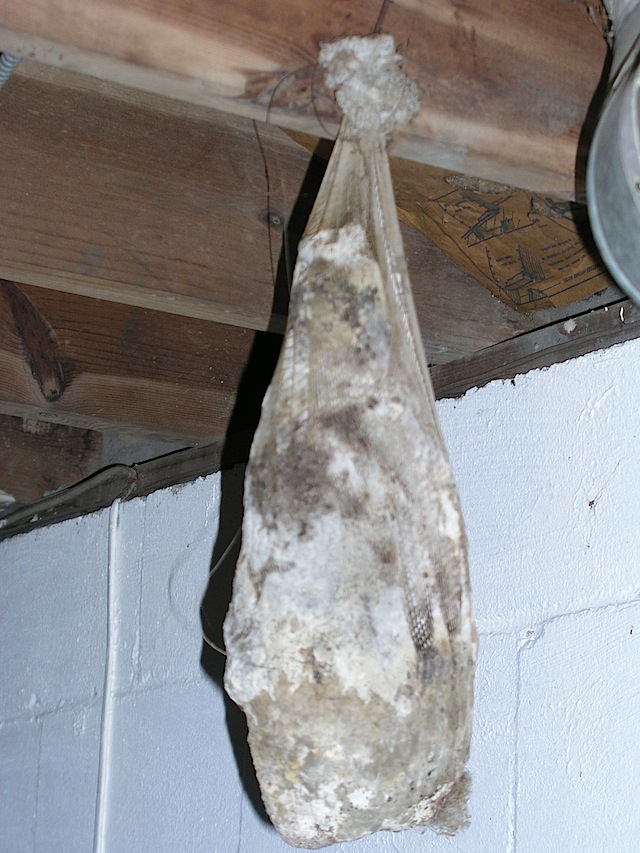
I tried to point some of this out to my dad, but he just scoffed. “One of these days, I’m going to take it out to my club…” (He was the sort of pillar-of-the-community man who had a club.) “…and give it to the chef. He’ll know how to prepare it. I’ll have a dinner party for my friends. It’ll be a gourmet feast.”
“Dad,” I said. “Your friends are all in their 80s. They will die.”
“Nonsense,” my father said. “It’s a Smithfield ham.”
* * *
My father died in the spring of 2008, at the ripe old age of 86, leaving behind three daughters, a house, and the ham.
After we’d taken care of all the urgent and important tasks that come with losing a parent, my sister Mary and I looked at each other and said. “What are we going to do with the ham?”
“Do you want it?” I asked.
“God, no!” She made a face. “I’d have nightmares. Do you?”
I shook my head. “But we can’t just throw it out.”
After a minute, Mary said. “I think we should have a Viking funeral. We’ll go out to a lake and put it on a raft and set it on fire.”
“We don’t have a lake.”
“We’ll take it to a park, then.”
“We are 50-year-old women. We can’t just set a toxic ham on fire in a public place. We’ll get caught. We’ll get arrested.”
“Okay, so how about we take it to Dad’s club and leave it on the 18th green and run?”
“People know us. We’re ‘Jack’s girls.’ We’ll get even more caught.”
“You are no fun,” she said.
The ham remained hanging in its room in the basement.
Meanwhile, there was probate and there were lawyers and banks and insurance and real estate people to be dealt with, because my father was a good Republican church-going Ohio businessman. And as the oldest daughter, it fell to me to meet them at the house and deal with appraisals and paperwork.
They were very professional, most of them women a bit younger than me, in power suits with power scarves and sensible heels. They were proper and respectful. And at some point in the middle of one of those visits, I would say, in my most polite hostess voice, “Would you like to see the ham?”
There would always be a pause, a slightly disconcerted look, and then they would smile and say, “Why certainly,” although they had no idea why I wanted to show them a ham.
So I’d turn on the light and lead them down the creaky basement stairs, and stop at the bottom. I’d open the door on the right just enough to reach in and turn on the light, and then I’d fling it wide open, and say, with pride in my voice: “This is our ham!”
Every time, the woman would leap back and emit a sound between a strangled squeal and a full-out scream.
I began to enjoy those visits.
It was a very scary ham.
* * *
I must add here that my father bought the house in 1951, and died in 2008, so there was 57 years worth of household stuff from basement to attic. And no one in my family throws things away, so I spent that summer clearing out my childhood, and my parents’ entire lives, and a fair amount of several ancestors’ worldly goods. It took months.
Dad had died in April, and finally, at the end of August, I’d gone through every closet, cupboard, cabinet, drawer, and box that I could find. I’d shipped home the few pieces of furniture I wanted, innumerable cartons of photos and memorabilia, filled two large dumpsters. It was time for an estate sale and then getting a crew to clean out the house and put it on the market.
The ham was still hanging in the basement.
Every month or so I’d call Mary and ask about whether she wanted me to set aside various things, what she wanted to do with Mom’s wedding dress and Dad’s army uniform, questions that I couldn’t answer by myself. And near the end of each call. I’d say, “What about the ham?”
“A Viking funeral!” she’d say. And I’d sigh and say no.
(I should clarify. I have two sisters, both younger. One has Down Syndrome, one is an English professor. I tell many stories about my family, and it’s not always easy to figure out which sister I’m talking about. In this case, it’s the professor.)
Finally, at the end of August, Mary flew to Ohio for a week to sort through the last of the stuff, say goodbye to the house we grew up in, and load Dad’s minivan with furniture and boxes and drive back to Colorado.
On the second-to-last-day of her trip, I said, “The ham. We have to deal with the ham and we have to do it today or tomorrow.” I gave her the big-sister stare. “Do not mention Vikings. We are not lighting it on fire.”
“Poophead,” she said. “But we have to have a funeral.”
“Absolutely.”
And so it began.
For my entire life, there had been a large gilt-and-white box that sat on a shelf in the family room, full of random snapshots. It was the sort of decorative box that one’s midwestern family has. We’d sorted through all the photos, and the box was going into the estate sale, but….
It was just the right size for the ham.
I put a bandana around my face and cut the ham down from its mooring in the basement ceiling. Mary went out and bought a length of red velvet. We draped it across the box and laid the ham out in state.
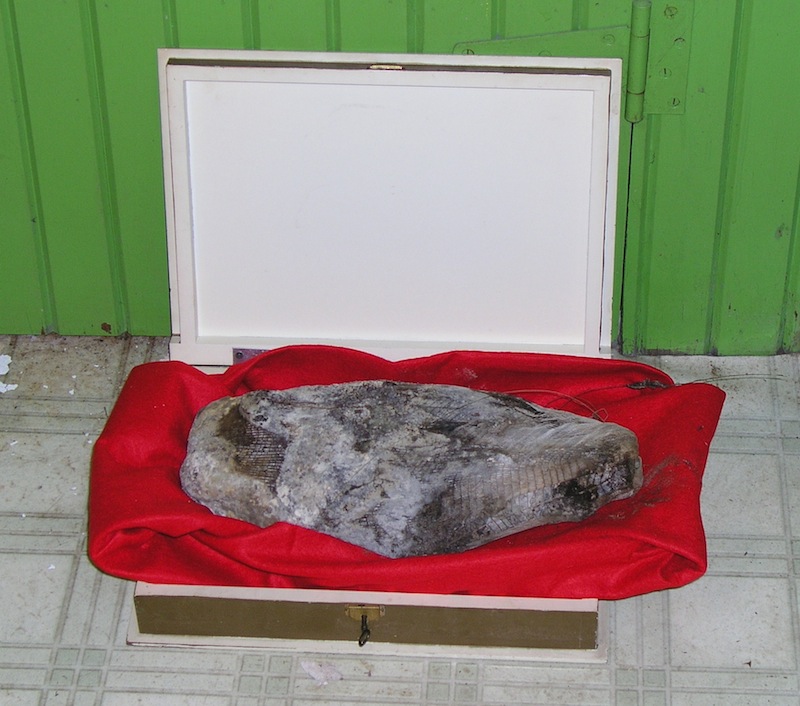
It looked better in the box. Like a mummified Egyptian baby. A small baby, maybe a few months old, wrapped in moldering cloth, resting on red velvet.
We took the box out to the backyard and set it in the shade of the towering elm tree. It looked rather sad and forlorn. We needed more accessories.
In the process of cleaning out the house, I had found many, many things whose existence I had never been aware of. There were cupboards that had been forbidden when I was a kid, and which I had no reason to look into on visits as an adult, and there were corners of the basement and attic that were just too deep in other clutter to have ever been visible.
At some point during the summer, I had found a trio of stuffed monkeys. Not taxidermy, just toys. Stuffed animals. Because I had two sisters, many items had come in threes—Christmas stockings, Easter baskets, matching beach towels. So three girls, three monkeys.
Except that I am the oldest, and I sell vintage toys on eBay, and I could tell that these monkeys significantly predated me. And they were very grubby and well-worn. Maybe well-loved, but I had no idea by whom. I had never seen them before.
But there they were, and they seemed to go with the ham, so we arrayed two of them around the gilt box. (The third one was too far gone to display.)
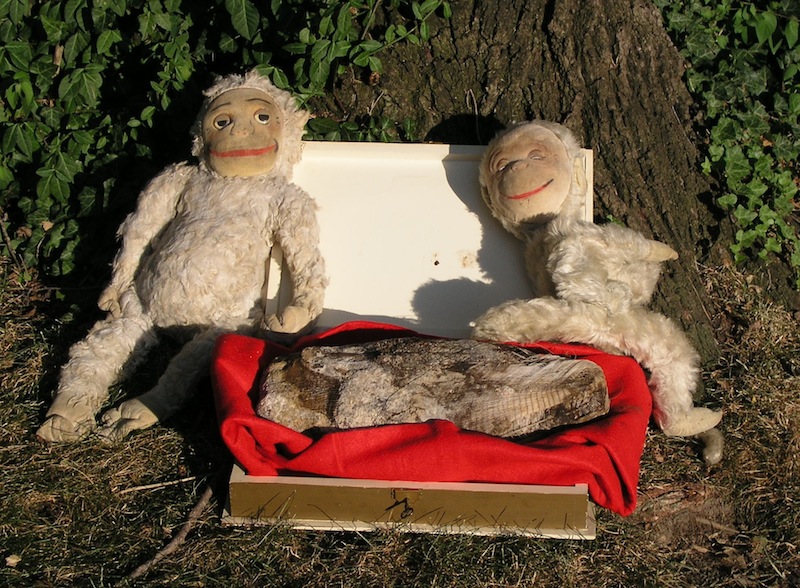
I had also discovered a hunting horn, about four feet long, the sort one might use to open the Derby or announce the release of the foxes. Never seen it before, either, but after four months, I was taking that sort of thing in stride. I took the horn out to the backyard and attempted to play Taps.
I have very little musical ability, and no experience with actual instruments, so I did not come close to succeeding, but I did make loud noises, and at one point played what might have been a bit of the Ohio State fight song. Appropriate enough for a Columbus, Ohio ceremony.
To complete the array, we had a shoebox full of used birthday candles. I do not know why my mother saved them. Even in an emergency, a used birthday candle will burn for, what, like an eighth of a second? But she had saved hundreds of them, so we doused them with lighter fluid, put the shoebox in front of the ham, and set the candles all on fire.
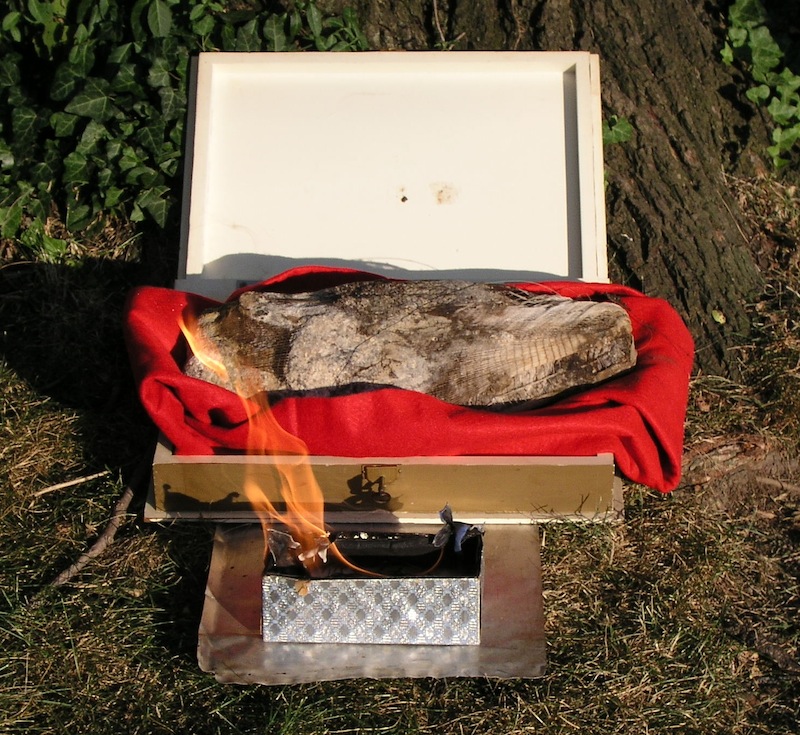
Between that and the hunting horn, it was sort of Viking-ish.
Soon we noticed that a few neighbors were peering over the fences that surrounded my Dad’s suburban backyard, to see what that horrible noise was, and stood, staring, at the flaming box and the decrepit monkeys and the very, very dead ham.
We waved. Nothing to see here. I stopped playing the horn. We ran the hose over what was left of the box of candles, wrapped the ham in its red velvet shroud, and got into the car. We drove to a local park. No raft, no more flammable materials, but there was a creek, so we figured we’d toss the ham into the water and say something nice about it.
A lovely little park, in the town we grew up in. We thought we’d just saunter down to the creek and have a ham toss and that would be that. But it was late in the afternoon, in August, on a Saturday, and about 400 families were having a picnic. We didn’t know all of them—it had been a long time since Mary or I had lived there—but we knew some. And we walked through their sea of plaid blankets and plastic tablecloths cradling what looked for all intents and purposes like a dead baby.
We smiled at people. I kept pointing to the bundle in my arms and mouthing, “Just a ham. Just a ham.” If anyone heard me, I doubt this was reassuring.
We finally got to the woods, and to the creek. Mary said a few words in Episcopalian, and I unwrapped the ham for the last time.
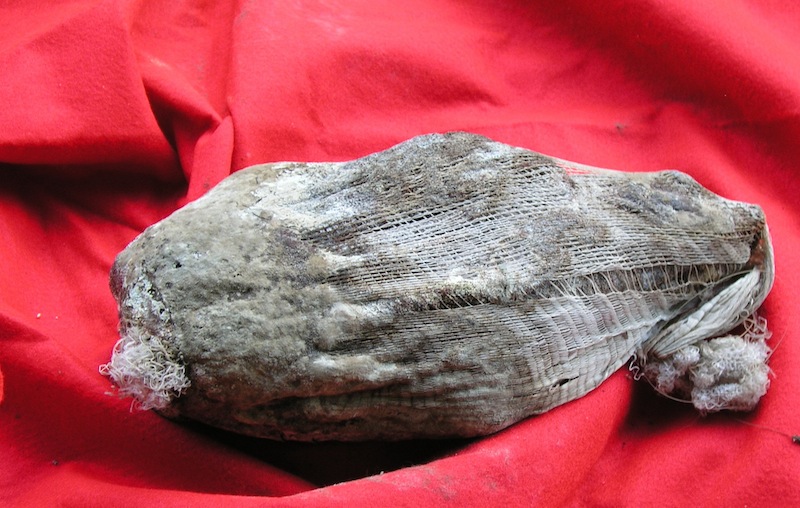
I swung once, twice, three times, getting enough momentum to actually get it up and out over the water, then let go and the ham sailed a few feet then sank like a prehistoric stone thing. Very fast. No bubbles, just a great bloop! and then nothing.
Requiescat in pace, perna formidilosa

We folded the red velvet into a triangle, like a flag, left it by the creek, and went to have a few beers.
On Monday, Mary drove home. I spent another ten days finishing up the odds and ends at the house, checking the paper every single day to see if there were any reports of fish floating belly-up downstream, or people in Circleville dying of a mysterious plague.
No news was good news.
As far as I know, the ham is still there, at the bottom of the creek. Perhaps unchanged. I doubt that it was edible, by any sort of creature, and I’m not sure any substance could dissolve it. After I’d cut it down from the basement ceiling, I tried to carve into it, to see how far down through the mold and mildew I’d have to go before I hit recognizable ham-like-meat. I never found out. I broke three knives trying.
It was a very scary ham.
Ellen Klages is an American science fiction, fantasy, and historical-fiction writer born in Columbus, Ohio in 1954. She began publishing short fantasy and SF stories in 1998; her novelette “Basement Magic” (2003) won a Nebula Award. In 2006 she published her first novel, The Green Glass Sea, a middle-grade novel set in Los Alamos during World War II; it won the Scott O’Dell Award for Historical Fiction. Portable Childhoods, a collection of her short fiction, appeared in 2007. Her Hugo-nominated story “Wakulla Springs,” co-authored with Andy Duncan, is available to read for free here on Tor.com.










